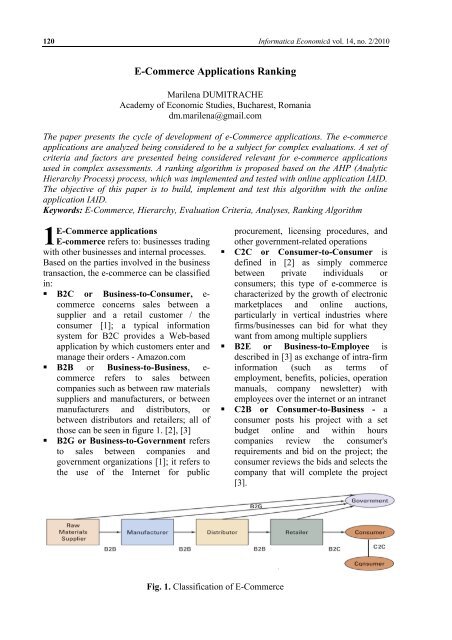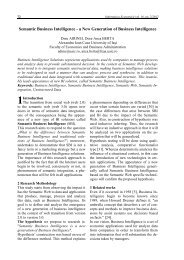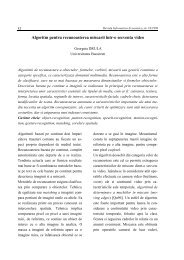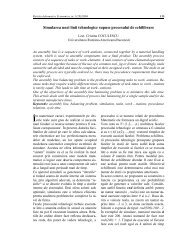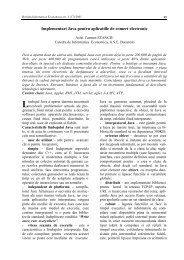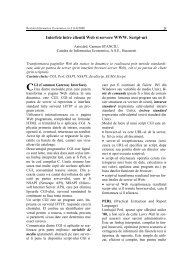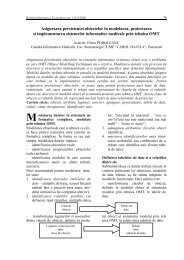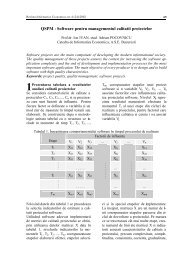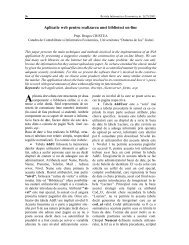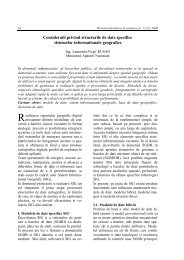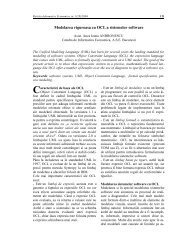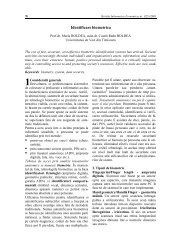E-Commerce Applications Ranking
E-Commerce Applications Ranking
E-Commerce Applications Ranking
You also want an ePaper? Increase the reach of your titles
YUMPU automatically turns print PDFs into web optimized ePapers that Google loves.
120 Informatica Economică vol. 14, no. 2/2010<br />
E-<strong>Commerce</strong> <strong>Applications</strong> <strong>Ranking</strong><br />
Marilena DUMITRACHE<br />
Academy of Economic Studies, Bucharest, Romania<br />
dm.marilena@gmail.com<br />
The paper presents the cycle of development of e-<strong>Commerce</strong> applications. The e-commerce<br />
applications are analyzed being considered to be a subject for complex evaluations. A set of<br />
criteria and factors are presented being considered relevant for e-commerce applications<br />
used in complex assessments. A ranking algorithm is proposed based on the AHP (Analytic<br />
Hierarchy Process) process, which was implemented and tested with online application IAID.<br />
The objective of this paper is to build, implement and test this algorithm with the online<br />
application IAID.<br />
Keywords: E-<strong>Commerce</strong>, Hierarchy, Evaluation Criteria, Analyses, <strong>Ranking</strong> Algorithm<br />
1<br />
E-<strong>Commerce</strong> applications<br />
E-commerce refers to: businesses trading<br />
with other businesses and internal processes.<br />
Based on the parties involved in the business<br />
transaction, the e-commerce can be classified<br />
in:<br />
� B2C or Business-to-Consumer, ecommerce<br />
concerns sales between a<br />
supplier and a retail customer / the<br />
consumer [1]; a typical information<br />
system for B2C provides a Web-based<br />
application by which customers enter and<br />
manage their orders - Amazon.com<br />
� B2B or Business-to-Business, ecommerce<br />
refers to sales between<br />
companies such as between raw materials<br />
suppliers and manufacturers, or between<br />
manufacturers and distributors, or<br />
between distributors and retailers; all of<br />
those can be seen in figure 1. [2], [3]<br />
� B2G or Business-to-Government refers<br />
to sales between companies and<br />
government organizations [1]; it refers to<br />
the use of the Internet for public<br />
Fig. 1. Classification of E-<strong>Commerce</strong><br />
procurement, licensing procedures, and<br />
other government-related operations<br />
� C2C or Consumer-to-Consumer is<br />
defined in [2] as simply commerce<br />
between private individuals or<br />
consumers; this type of e-commerce is<br />
characterized by the growth of electronic<br />
marketplaces and online auctions,<br />
particularly in vertical industries where<br />
firms/businesses can bid for what they<br />
want from among multiple suppliers<br />
� B2E or Business-to-Employee is<br />
described in [3] as exchange of intra-firm<br />
information (such as terms of<br />
employment, benefits, policies, operation<br />
manuals, company newsletter) with<br />
employees over the internet or an intranet<br />
� C2B or Consumer-to-Business - a<br />
consumer posts his project with a set<br />
budget online and within hours<br />
companies review the consumer's<br />
requirements and bid on the project; the<br />
consumer reviews the bids and selects the<br />
company that will complete the project<br />
[3].
Informatica Economică vol. 14, no. 2/2010 121<br />
The e-commerce applications are mainly<br />
used because of the fallowing advantages:<br />
� reduced transaction cost;<br />
� flow increased for goods and services;<br />
� improved level of customer service;<br />
� close coordination enabled among<br />
manufacturers, suppliers, and customers;<br />
� Worldwide market accessibility.<br />
The sellers of e-commerce applications can<br />
maximize their revenues by using the<br />
collective intelligence of their Web site<br />
visitors while personalizing the application<br />
according to the customer needs creating in<br />
this way a great experience in real-time. Few<br />
years ago they were interested about how to<br />
manage, measure, and increase transactions.<br />
But most sellers have this figured out by<br />
now, so their focus has shifted to maximizing<br />
their revenues in new ways. Sellers have<br />
grown to be more interested in customer<br />
experience and service, personalization, and<br />
recommendations. Online retailers are<br />
looking for new ways to increase their<br />
revenues and to achieve better<br />
personalization meeting the customer goals.<br />
They are also looking for new ways to<br />
maximize revenues by deploying the<br />
recommendations they already have in place.<br />
The retailers have collected the benefits of<br />
the traditional product recommendations.<br />
Because they understand the capabilities of<br />
these technologies they are interested to<br />
tackle the newest issues such as navigating<br />
and social elements for their sites while<br />
ongoing the quest to improve the search.<br />
Therefore, the nature of the second wave of<br />
electronic commerce is related with:<br />
� Collective intelligence;<br />
� Self-service;<br />
� Customer centricity;<br />
Fig. 2. The e-commerce project phases<br />
� Personalization;<br />
� Recommendation.<br />
The e-<strong>Commerce</strong> market is still in its<br />
preliminary phase. Developing an e-<br />
<strong>Commerce</strong> project implies a certain amount<br />
of risk. It is known that there are also<br />
projects that can overpass the deadline, there<br />
are even projects that do not fit in between<br />
the allocated budget, sometimes good<br />
projects can offer the expected results, but<br />
sometimes they don’t. It is known that there<br />
are differences between the estimations and<br />
the outcome, but despite all the mentioned<br />
above this project will present a realistic<br />
algorithm which is meant to rank the ecommerce<br />
applications.<br />
In order to succeed with an e-<strong>Commerce</strong><br />
business, one must imminently start by<br />
developing a well structured business plan. A<br />
well structured plan must be based on<br />
accurate information. In order to bring<br />
innovative ideas to the plan the management<br />
team must be flexible and creative. The main<br />
idea is that a strong business plan represents<br />
a successful business. All the projected goals<br />
must be reached within the estimated period<br />
of time while making use of the developed<br />
Internet activity. The information must be<br />
used in order to constantly create report<br />
sheets and update the business plan. The<br />
entire time the team must fallow the two<br />
main guidelines of every business: the<br />
breakeven point and the profitability ratio.<br />
[4]<br />
Creating an e-commerce project implies tasks<br />
organization – the tasks must take place in a<br />
logical and sequential order. Figure 2<br />
proposes the phases’ list for an e-commerce<br />
project.
122 Informatica Economică vol. 14, no. 2/2010<br />
Each phase is involves activities and tasks.<br />
Reference [5] describes important features of<br />
e-commerce applications. The quality of the<br />
e-commerce applications is very important,<br />
and because of that in Romania there’s a<br />
periodically organized competition which is<br />
meant to verify and ensure the quality for<br />
these applications. This competition is being<br />
healed each year since 2006 and it is called<br />
GPeC (Gala Premiilor in e<strong>Commerce</strong> -<br />
Awards in e<strong>Commerce</strong>). This competition<br />
offers prices as “Store of the Year in e-<br />
<strong>Commerce</strong> and Best Start-up in e-<br />
<strong>Commerce</strong>”. Table 1 is meant to present the<br />
awards and the criteria used for judging<br />
between the years 2006 and 2009.<br />
Table 1. Awards in e<strong>Commerce</strong><br />
Year Store of the Year in Best Start-up in Criteria for judging<br />
e-<strong>Commerce</strong> e-<strong>Commerce</strong><br />
2006 eMag.ro - -functionality<br />
-design<br />
-content<br />
-originality and visibility<br />
-professionalism/Customer<br />
Experience (20%)<br />
2007 FunGift.ro - - functionality<br />
-design & usability<br />
-content<br />
-legality<br />
-Customer Experience (50%)<br />
2008 Marketonline.ro Vexio.ro - functionality<br />
-design & usability<br />
-content<br />
-legality<br />
-Customer Experience (50%)<br />
2009 Vexio.ro LiveMag.ro & - site achievement<br />
Strollers.ro 1. Time to access the site<br />
2. Accessibility<br />
3. Source Code<br />
4. Graphic design<br />
5. Content<br />
6. Legality and the elements that<br />
give confidence to shop<br />
7. Interacting with users. Elements<br />
of PR and promotion<br />
8. Search Engine Optimization<br />
9. Security<br />
-usability & customer experience<br />
(60%)<br />
1. Usability and navigation<br />
2. Easy to place an order<br />
3. Easy account creation and<br />
authentication<br />
4. Confirmation Code<br />
5. Professionalism. Store Services
Informatica Economică vol. 14, no. 2/2010 123<br />
With respect towards the judging criteria it<br />
can be easily seen in table 1 that the usability<br />
and customer experience has been<br />
emphasized and so it registered each year an<br />
increase. Table 1 also shows that with each<br />
year that has past the evaluation’s criteria has<br />
been improved significantly, which clearly<br />
demonstrates that the idea of hierarchy is<br />
becoming more and more important for both<br />
producers and users.<br />
2 The criteria for e-<strong>Commerce</strong><br />
applications<br />
Reference [6] presents the criteria for e-<br />
<strong>Commerce</strong> applications which are grouped<br />
into 4 main categories: information quality,<br />
service quality, systems quality, and vendor-<br />
specific quality.<br />
Information quality, in the e-commerce<br />
context, insinuates delivering relevant,<br />
updated, and easy-to-understand information<br />
to significantly influence online customers’<br />
attitude, satisfaction, and purchases. It is<br />
suggested that the higher the quality of the<br />
website information, the more online<br />
customers would select that website for<br />
online shopping. Information quality can be<br />
measured using information relevance,<br />
currency, and understandability. [6] Web<br />
content should be personalized, complete,<br />
relevant, easy to understand, and secure if we<br />
expect prospective buyers or suppliers to<br />
initiate transactions via the Internet and<br />
return to the site on a regular basis. [7]<br />
Table 2. Sub-criteria for information quality<br />
Sub-criteria Sub-criteria meaning<br />
Information relevance Relevant depth and scope, and completeness of the<br />
information<br />
Currency Updating of the information<br />
Understandability ease of understanding and clearness of the information<br />
System quality - in the e-commerce context,<br />
website system quality has been known to<br />
have a significant effect on online customer<br />
satisfaction and online purchases. Customers<br />
dissatisfied with websites characterized by<br />
poor navigation, slowness, non-vividness,<br />
being unsecured, and with no personalized<br />
services are likely to leave the site even<br />
though the information provided by the<br />
website is of high quality. System quality can<br />
be measured using navigability, response<br />
time, personalization, tele-presence, and<br />
security. [6]<br />
Usability, availability, reliability,<br />
adaptability, and response time, are examples<br />
of qualities that are valued by users of an ecommerce<br />
system. [7] [8]<br />
Table 3. Sub-criteria for system quality<br />
Sub-criteria Sub-criteria meaning<br />
Navigability the website’s capability to provide alternative interaction and<br />
navigating techniques<br />
Response time the interval between a user-command and the receipt of an action,<br />
result, or feedback from the system<br />
Personalization provide online customers an individualized interface, and creation of<br />
custom tailored services (such as news pages on the web or specialized<br />
newsletters) that meet the individual customer's particular needs or<br />
preferences<br />
Tele-presence a set of technologies which allow a person to feel as if they were<br />
present, to give the appearance that they were present, or to have an<br />
effect, at a location other than their true location<br />
Security the implementation of multiple features like encryption, third-party<br />
affiliations, security statement, to assure secure online shopping
124 Informatica Economică vol. 14, no. 2/2010<br />
Service quality, in the e-commerce context,<br />
becomes more critical because online<br />
customers transact with unseen retailers.<br />
Reliability, responsiveness, and empathy are<br />
applicable to measure e-commerce service<br />
quality [6].<br />
Table 4. Sub-criteria for service quality<br />
Sub-criteria Sub-criteria meaning<br />
Reliability the ability to perform the promised service dependably<br />
and accurately<br />
Responsiveness the willingness to help online customers and provide<br />
prompt service<br />
Empathy the caring and attention the online retailer provides its<br />
customers<br />
Also along with the three website quality<br />
criteria discussed above, the Internet vendorspecific<br />
quality has been considered to be an<br />
important e-commerce success criterion. [6]<br />
It refers to the awareness of Internet vendors<br />
and their reputation and price<br />
competitiveness.<br />
Table 5. Sub-criteria for vendor-specific quality<br />
Sub-criteria Sub-criteria meaning<br />
Awareness is related to brand loyalty and network effects<br />
Price savings a cost-focus strategy and selling commodity items where<br />
each vendor has the exact same product<br />
Reputation overall estimation of the character or quality of a site of<br />
e-commerce generally held by those who know it<br />
An E-<strong>Commerce</strong> application can be<br />
considered successful if users are satisfied by<br />
the presented criteria’s quality and revisit the<br />
web site. It is crucial to determine what<br />
satisfies a user, with respect to the e-<br />
<strong>Commerce</strong> application, and what the<br />
potential causes of dissatisfaction are. For<br />
this reason it is very important to determine<br />
which criteria are preferred by users in the ecommerce<br />
applications.<br />
3 Analytic hierarchy process (AHP)<br />
The Analytic Hierarchy Process is a multicriteria<br />
decision-making method allowing<br />
decision makers to model a complex problem<br />
into simple hierarchical structure which<br />
consists of goal, objectives (criteria), subobjectives,<br />
and alternatives. It was developed<br />
by Thomas L. Saaty in the 1980 and has been<br />
extensively studied and refined since then,<br />
for instance has been widely used for<br />
evaluation of the software packages. To<br />
judge which of each pair is preferred or has a<br />
greater amount of some quantitative<br />
property, based on pair wise comparison,<br />
which refers to any process of comparing<br />
entities in pairs, AHP integrates both criteria<br />
importance and alternative preference<br />
measures into a single overall score for<br />
ranking decision alternatives [5] [7] [8] [9]<br />
[10].<br />
AHP consists of four phases [11]:<br />
� Structuring the problem and model<br />
building;<br />
� Data collection through pair wise<br />
comparisons and measurement;<br />
� Calculation of normalized priority<br />
weights of individual factors;<br />
� Analyzing the priority weights and<br />
deriving solutions to the problem.<br />
Analytic hierarchy process has strengths and<br />
weaknesses [9].<br />
Strengths:<br />
� AHP enables decision makers to structure<br />
a decision making problem into a
Informatica Economică vol. 14, no. 2/2010 125<br />
hierarchy, helping them to understand<br />
and simplify the problem.<br />
� It is a flexible and powerful tool for<br />
handling both qualitative and quantitative<br />
multi-criteria problems.<br />
� AHP procedures are applicable to<br />
individual and group decision making.<br />
Weaknesses:<br />
- AHP is time consuming because of the<br />
mathematical calculations and number of<br />
pair-wise comparisons that increases<br />
while the number of alternatives and<br />
criteria increases.<br />
- The decision makers need to re-evaluate<br />
alternatives when the number of criteria<br />
or alternatives is changed.<br />
- <strong>Ranking</strong> of alternatives depends on the<br />
alternatives considered for evaluation,<br />
hence adding or deleting alternatives can<br />
lead to changes in the final rank.<br />
4 <strong>Ranking</strong> algorithm<br />
It is important to question the users of ecommerce<br />
applications with regards towards<br />
the features of the application. This<br />
information is used by managers or designers<br />
in order to alter their priorities as for the<br />
factors of the site to meet the priorities of the<br />
customers. These will help them make the<br />
proper allocation of resources so as to<br />
increase the competitiveness for the<br />
electronic commerce site while maximizing<br />
the business performance.<br />
A ranking algorithm with 5 steps is proposed,<br />
based on the AHP process that was presented<br />
in the previous subsection. The algorithm for<br />
ranking of e-commerce websites involves a<br />
problem Pr for which the alternatives (ecommerce<br />
websites) A1, A2, ..., An are taken<br />
into analysis. For these alternatives the<br />
evaluation criteria C1, C2, ..., Cm are<br />
established,<br />
where:<br />
n - number of alternatives under examination<br />
(e-commerce websites)<br />
m - number of evaluation criteria<br />
The optimum e-commerce website is chosen<br />
after determining the evaluation criteria and<br />
after computing the criteria’s weights and<br />
alternatives.<br />
The ranking algorithm fallows the next 5<br />
steps.<br />
Step 1: Initial data input – a number of<br />
electronic websites and a specific number of<br />
criteria are chosen for the analysis.<br />
Step 2: Define alternatives –defining the<br />
alternatives under examination (e-commerce<br />
websites)<br />
Step 3: Define evaluation criteria –the<br />
evaluation criteria is defined after the<br />
alternatives were tested according to<br />
literature.<br />
Before step 4 the weight ratio is defined by<br />
a i<br />
a ij �<br />
a j<br />
where:<br />
ai - weight of criterion i, i = 1, 2, . . . m<br />
aj - weight of criterion j, j = 1, 2, . . . m<br />
m - the number of criteria<br />
In this case for any i, j, t indexes:<br />
�1<br />
a ij � a ji ; a ij � ait<br />
* atj<br />
for any i, j, t<br />
where:<br />
ait = the importance given to criterion i in<br />
comparison with criterion t, t = 1,2, …, m<br />
atj = the importance given to criterion t in<br />
comparison with criterion j<br />
Step 4: Define criteria’ weights –<br />
constructing a pair wise comparison matrix<br />
with a scale of relative importance. For a<br />
criterion compared with itself is always<br />
assigned the value 1 by convention, so all the<br />
main diagonal entries of the pair wise<br />
comparison matrix are 1. If there are m<br />
criteria, then the pair of wise comparisons<br />
will yield a square matrix as the matrix A:<br />
� 1 a12<br />
... a1m<br />
�<br />
�<br />
�<br />
� � �<br />
a 21 1 ... a2m<br />
A [ a ]<br />
�<br />
ij<br />
� ... ... 1 ... �<br />
�<br />
�<br />
�am1<br />
am2<br />
... 1 �<br />
where :<br />
aij - the weight ratio - the importance given<br />
to the criterion i in comparison with the<br />
criterion j, with values between 1 and 9 or<br />
fractions like 1 / x (with x between 1 and 9)<br />
to reverse the importance, i, j = 1..m<br />
In this context, as Saaty’s scale of relative<br />
importance [14], the numbers represent:
126 Informatica Economică vol. 14, no. 2/2010<br />
1: equal importance, 3: moderate importance<br />
of one over another, 5: essential or strong<br />
importance, 7: very strong importance, 9:<br />
extreme importance, 2, 4, 6, 8 are<br />
intermediate values between the two adjacent<br />
judgments.<br />
Step 5: Define alternatives’ weights -<br />
constructing a matrix with a scale of relative<br />
importance in which it is compared the<br />
alternatives on each of the criteria. If there<br />
are m criteria, then the pair wise comparisons<br />
would yield a square matrix as the matrix B<br />
below:<br />
� 1 b12<br />
... b1n<br />
�<br />
�<br />
b 1 ... b<br />
�<br />
where:<br />
B<br />
i<br />
� [ b<br />
kl<br />
] � �<br />
21<br />
� ...<br />
�<br />
�bn1<br />
b<br />
...<br />
n2<br />
1<br />
...<br />
2n<br />
�<br />
... �<br />
�<br />
1 �<br />
bkl - the importance given to criterion i for<br />
the alternative k in comparison with<br />
alternative l with values between 1 and 9 or<br />
fractions like 1 / x (with x between 1 and 9)<br />
to reverse the importance<br />
�1<br />
b lk � bkl<br />
; k, l = 1..n<br />
n - the number of alternatives<br />
The significance of the matrix values is the<br />
same like in step 4.<br />
Computations<br />
The geometric means of criterion and the<br />
relative weights of criteria (priorities) are<br />
computed.<br />
The geometric means of criterion i are<br />
computed as:<br />
m<br />
GM i � m �<br />
j�1<br />
a<br />
ij<br />
4.1<br />
where:<br />
aij - the importance given to criterion i in<br />
comparison with criterion j , i,j = 1..m<br />
The relative priority of criterion j is:<br />
PC i<br />
GM i<br />
� m<br />
GM<br />
4.2<br />
where:<br />
�<br />
j�1<br />
j<br />
GMj - geometric mean of criterion j<br />
In the same way is calculated the geometric<br />
mean of criterion i and alternative k.<br />
n<br />
GM n<br />
ik � �<br />
l�1<br />
b<br />
kl<br />
4.3<br />
where:<br />
bkl - the importance given to criterion i for the<br />
alternative k in comparison with<br />
alternative l, k,l = 1..n<br />
The relative priority of criterion i for<br />
alternative k,<br />
GM<br />
ik<br />
RPC ik � 4.4<br />
n<br />
�GMil l�1 where:<br />
GMik - geometric mean of criterion i and<br />
alternative k<br />
GMil - geometric mean of criterion i and<br />
alternative l<br />
The global priority for alternative k is:<br />
PGk<br />
�<br />
m<br />
�<br />
i�1<br />
(PC * RPC ) 4.5<br />
i<br />
where:<br />
PCi - relative priority of criterion i, i = 1..m<br />
RPC ik - relative priority of criterion i for<br />
alternative k, k = 1..n<br />
Global priorities are sorted in a descending<br />
ordered and the optimum choice is the<br />
alternative (e-commerce website) with the<br />
highest global priority.<br />
Let there be considered the following<br />
alternatives (e-<strong>Commerce</strong> websites): e-<br />
Mag.ro, Marketonline.ro, Vexio.ro - and 3<br />
evaluations criteria – information relevance,<br />
under-stability and personalization.<br />
The pair wise comparison matrix with a scale<br />
of relative importance is:<br />
� 1 6 3�<br />
A �<br />
�<br />
�<br />
�<br />
1/<br />
6 1 2<br />
�<br />
��<br />
1/<br />
3 1/<br />
2 1��<br />
If the formula 4.1 is applied, we obtain the<br />
values in table 6.<br />
ik
Informatica Economică vol. 14, no. 2/2010 127<br />
Table 6. Values for geometric mean of<br />
criteria<br />
GM1<br />
2,6207<br />
GM2<br />
0,6933<br />
GM3<br />
0,5503<br />
Values for relative priority of criteria in table<br />
7 are obtained, if we apply the formula 4.2.<br />
Table 7. Values for relative priority of<br />
criteria<br />
PC1<br />
0,6781<br />
PC 2<br />
0,1794<br />
0,1424<br />
PC 3<br />
Here are the matrices in which it is compared<br />
the alternatives on each of the criteria:<br />
B 1<br />
B 2<br />
B 3<br />
�1<br />
�<br />
�<br />
�<br />
2<br />
��<br />
3<br />
�1<br />
�<br />
�<br />
�<br />
2<br />
��<br />
3<br />
�1<br />
�<br />
�<br />
�<br />
1<br />
��<br />
2<br />
1/<br />
2<br />
1<br />
2<br />
1/<br />
2<br />
1<br />
3<br />
1<br />
1<br />
1/<br />
2<br />
1/<br />
3�<br />
1/<br />
2<br />
�<br />
�<br />
1 ��<br />
1/<br />
3�<br />
1/<br />
3<br />
�<br />
�<br />
1 ��<br />
1/<br />
2�<br />
2<br />
�<br />
�<br />
1 ��<br />
In table 8 the values for geometric mean of<br />
criterion i and alternative k, obtained with<br />
formula 4.3 are presented:<br />
Table 8. Values for geometric mean of criteria<br />
GM11 0,5503 GM21 0,5503 GM31 0,7937<br />
GM12 1 GM22 0,8735 GM32 1,2599<br />
GM13 1,8171 GM23 2,0800 GM33 1<br />
sum 3,3674 sum 3,5039 Sum 3,0536<br />
The values for relative priority of criteria<br />
are computed using formula 4.4 and are<br />
presented in table 9.<br />
Table 9. Sub-criteria for vendor-specific quality<br />
PC11 0,1634 PC 21 0,1570 PC 31 0,2599<br />
PC 12 0,2969 PC 22 0,2493 PC 32 0,4125<br />
PC 13 0,5396 PC 23 0,5936 PC 33 0,3274<br />
We obtain values of global priorities for<br />
alternative k (k=1, 2, 3):<br />
PG 1 = 0,1760;<br />
PG 2 = 0,3048;<br />
PG 3 = 0,5190.<br />
The global priority values are descendant<br />
ordered and the optimum choice in this case<br />
is the alternative 3 because it is the highest<br />
one.<br />
6 Experimental results obtained through<br />
the online application<br />
The algorithm is implemented and tested<br />
with the online application IAID, running an<br />
Apache server (version 2.2) for processing<br />
the PHP pages and a MySQL server (version<br />
5.1) for hosting the database.<br />
The implementation of the ranking algorithm<br />
is built in a wizard-like form, so that the user<br />
is guided through a series of steps in order to<br />
input data into the algorithm. After the last<br />
step the results are displayed presenting their<br />
interpretation in textual and graphical form.
128 Informatica Economică vol. 14, no. 2/2010<br />
The number of alternatives and the number<br />
of criteria (initial data) were chosen in step 1.<br />
Therefore, in step 2 – figure 3, a number of 3<br />
alternatives were defined (site of e-<br />
The significance of the criteria chosen can be<br />
found in tables 2-5.<br />
In step 4 the criteria’ weights are defined.<br />
The importance given to each criterion, with<br />
Fig. 3. Alternatives definition<br />
Fig. 4. Evaluation criteria<br />
Fig. 5. Weights of criteria<br />
commerce) in order to be explored.<br />
According to the literature, in step 3 – figure<br />
4, the alternatives were used while for each<br />
of them 6 criteria were chosen [8] [12] [13].<br />
values between 1 and 9 or fractions like 1 / x<br />
(with x between 1 and 9) to reverse the<br />
importance, can be seen in figure 5.
Informatica Economică vol. 14, no. 2/2010 129<br />
The significance of the values can be found<br />
in the description of each algorithm step.<br />
In step 5 are defined the alternatives’<br />
weights. The importance given to each<br />
In figure 7, the results of the algorithm can<br />
be observed (values of global priorities, the<br />
optimum choice).<br />
The values for global priorities are 0.2065 for<br />
the alternative eMag.ro, 0.3165 for the<br />
alternative Marketonline.ro and 0.4785 for<br />
the alternative Vexio.ro. Figure 7 shows a<br />
ranking of these values in an ascendant order.<br />
The preferred website (the optimum choice)<br />
is the e-commerce website Vexio.ro.<br />
Fig. 6. Alternatives’ weights<br />
alternative, with values between 1 and 9 or<br />
fractions like 1 / x (with x between 1 and 9)<br />
to reverse the importance, can be seen in<br />
figure 6.
130 Informatica Economică vol. 14, no. 2/2010<br />
7 Conclusion<br />
Nowadays the competition increases daily.<br />
The businesses are required to show<br />
flexibility, in order to modify themselves to<br />
the stable situations of the market change,<br />
readiness for constant innovation and<br />
guarantee of quality for products and<br />
services. Even so there are e-commerce sites<br />
do not fully satisfy all the customer’s<br />
requirements, and those insufficiencies might<br />
eventually threaten the very existence of<br />
many of those companies in the market.<br />
This article presents the cycle of<br />
development of e-<strong>Commerce</strong> applications<br />
and the e-<strong>Commerce</strong> applications which were<br />
subject to complex evaluations. By adopting<br />
DeLone and McLean’s IS success model and<br />
applying a ranking algorithm based on the<br />
AHP method, this study investigated factors<br />
Fig. 7. Results<br />
affecting the website selection, the factors’<br />
relative importance, and the priority of<br />
alternative websites. In the end the study<br />
validated the ranking algorithm. This<br />
algorithm is chosen for the e-commerce sites,<br />
through the identification and ranking of<br />
their main quality characteristics, as well as<br />
an examination of the different developers<br />
and users’ points of view. To achieve the<br />
preferred quality of software products, it is<br />
necessary to produce models that allow<br />
evaluation of those products quality.<br />
According to ISO, the main purpose of<br />
software quality evaluation is to provide<br />
results to the software products that are<br />
reliable, understandable and acceptable to<br />
anyone interested. User satisfaction is also an<br />
important consideration.
Informatica Economică vol. 14, no. 2/2010 131<br />
In order to choose the preferred site of ecommerce<br />
applications, the goals of the<br />
customer are very important because:<br />
� Customer value should be the business<br />
driver for competitiveness<br />
� Customers are an essential and critical<br />
component of the information systems<br />
development and their participation and<br />
satisfaction allow the system to derive its<br />
value.<br />
� The system’s development focus is to<br />
construct a variety of components for the<br />
customer’s chain driven value in order to<br />
meet the customer’s changing value.<br />
The study showed that each of the four<br />
website quality factors were relevant criteria<br />
in selecting the preferred website.<br />
The ranking algorithm solves a complex<br />
website selection problem. AHP can be<br />
applied to future studies solving various<br />
multi-criteria decision making problems in ecommerce<br />
areas, and also in e-business areas.<br />
The proposed ranking algorithm can be used<br />
by managers or designers as a guide in order<br />
to measure the quality level of their websites.<br />
At the same time, the model can be used to<br />
compare a company’s website quality level<br />
with that of the competitors.<br />
References<br />
[1] D.T. Green and J. M. Pearson, “The<br />
examination of two web site usability<br />
instruments for use in B2C e-commerce<br />
organizations,” Journal of Computer<br />
Information Systems, Vol. 49, No. 4,<br />
2009, pp. 19-32<br />
[2] T. Wang and Y. Lin, “Accurately<br />
predicting the success of B2B ecommerce<br />
in small and medium<br />
enterprises,” Expert Systems with<br />
<strong>Applications</strong>, Vol. 36, No. 2, published<br />
by Elsevier, 2009, pp. 2750–2758.<br />
[3] M. Lazarica and I. Lungu, Aspecte<br />
privind proiectarea sistemelor de comert<br />
electronic, ASE Publishing House, 2007,<br />
pp. 147.<br />
[4] http://www.networkcomputing.com/917/<br />
917f2.html<br />
[5] I. Ivan, L. Săcuiu and D. Milodin,<br />
“Integrarea aplicaţiilor de comerţ<br />
electronic,” Revista Română de<br />
Informatică şi Automatică, Vol. 19, No.<br />
2, 2009, pp. 23 – 42.<br />
[6] Y. Lee and K. Kozar, “Investigating the<br />
effect of website quality on e-business<br />
success: An analytic hierarchy process<br />
(AHP) approach,” Decision Support<br />
Systems, Vol. 42, No. 3, published by<br />
Elsevier, 2006, pp. 1383–1401.<br />
[7] S. Värlander, “Online information quality<br />
in experiential consumption: An<br />
exploratory study,” Journal of Retailing<br />
and Consumer Services, Vol. 14, No. 5,<br />
2007, pp. 328-338.<br />
[8] E. K. Delice and Z. Gungor, “The<br />
usability analysis with heuristic<br />
evaluation and analytic hierarchy<br />
process,” International Journal of<br />
Industrial Ergonomics, Vol. 39, No.6,<br />
2009, pp. 934–939.<br />
[9] A. S. Jadhav and R. M. Sonar,<br />
“Evaluating and selecting software<br />
packages: A review,” Information and<br />
Software Technology, Vol. 51, No. 3,<br />
published by Elsevier, 2009, pp. 555–<br />
563.<br />
[10] http://en.wikipedia.org/wiki/Analytic_<br />
Hierarchy_ Process<br />
[11] M. Sambasivan and Y. Fei, “Evaluation<br />
of critical success factors of<br />
implementation of ISO 14001 using<br />
analytic hierarchy process (AHP): a case<br />
study from Malaysia,” Journal of Cleaner<br />
Production, Vol. 16, No. 13, published by<br />
Elsevier, 2008, pp. 1424-1433.<br />
[12] Y. Zhang and J. Jiao, “An associative<br />
classification-based recommendation<br />
system for personalization in B2C ecommerce<br />
applications,” Expert Systems<br />
with <strong>Applications</strong>, Vol. 33, No. 2,<br />
published by Elsevier, 2007, pp. 357–<br />
367.<br />
[13] A. Oulasvirta and J. Blom, “Motivations<br />
in personalisation behaviour,” Interacting<br />
with Computers, Vol. 20, No. 1,<br />
published by Elsevier, 2008, pp. 1–16.<br />
[14] M. K. Chen and S. C. Wang, “The<br />
critical factors of success for information<br />
service industry in developing<br />
international market: Using analytic
132 Informatica Economică vol. 14, no. 2/2010<br />
hierarchy process (AHP) approach,”<br />
Expert Systems with <strong>Applications</strong>, Vol.<br />
37, No. 1, published by Elsevier, 2010,<br />
pp. 694–704.<br />
[15] I. Ivan and C. Boja, Metode statistice in<br />
analiza software, ASE Publishing House,<br />
Bucharest, 2004, Available at:<br />
http://www.ionivan.ro/book11.php<br />
[16] J. Nantela and E. Glaser, “The impact of<br />
language and culture on perceived<br />
website usability,” Journal of<br />
Engineering and Technology<br />
Management, Vol. 25, No. 2, 2008, pp.<br />
112– 122.<br />
Marilena DUMITRACHE has a background in computer science and is<br />
interested in methods for ranking distributed applications. She has graduated<br />
the Faculty of Cybernetics of the Academy of Economic Studies in<br />
Bucharest. She is currently conducting doctoral research at the Academy of<br />
Economic Studies. Other fields of interest include e-commerce applications<br />
and project management.


